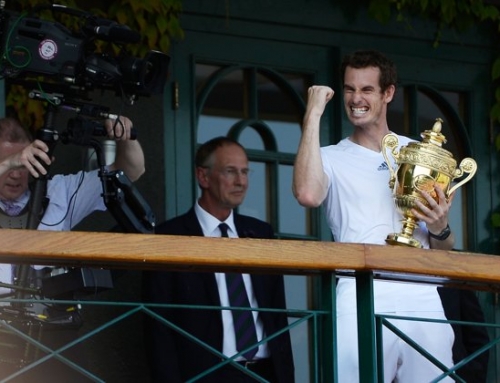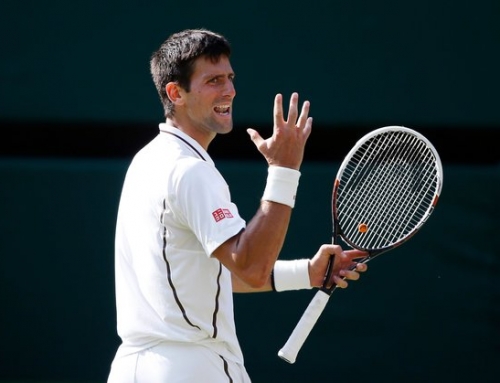 The day began with many Americans looking somewhere besides the lawns of Wimbledon. Down in South Africa, the US team, in Group C, was fighting for its World Cup lives. The math worked liked this. If the US beat Algeria, then the US would be one of two teams into the main draw. However, as many people know, soccer (football to the rest of the world) is a game that often leads to ties. Soccer games are known to tie 0-all and score lower than hockey.
The day began with many Americans looking somewhere besides the lawns of Wimbledon. Down in South Africa, the US team, in Group C, was fighting for its World Cup lives. The math worked liked this. If the US beat Algeria, then the US would be one of two teams into the main draw. However, as many people know, soccer (football to the rest of the world) is a game that often leads to ties. Soccer games are known to tie 0-all and score lower than hockey.
Compared to American sports like (American) football or basketball, soccer is blissfully fast. The main play is 90 continuous minutes. There are no timeouts, that drag a 60 minute game into several hours. When the action is delayed by a judge’s decision, time continues onward. Referees will then add time at the end, the so-called “stoppage” time which usually is a few minutes longer.
The US team was even under more pressure. The math allowed the US to tie and advance, provided England did not win its match against Slovenia. The England-Slovenia match was being played at nearly the same time, and they had taken a 1-0 lead early in that match. This potential win meant the US had to win, otherwise Slovenia and England would move forward, and the US would have to wait four years for their next opportunity.
The US had chances early on. Its best chance was a disallowed goal, one that was called off-sides (upon instant replay, which is disallowed in soccer, commentators said it was an incorrect call). The US had other chances at goal, but each time they had a corner kick or penalty kick, the ball failed to find the target. As time started to desperately wind down, the number ticking inexorably to 90:00, it looked like Algeria would be able to fend the US off.
When the 90:00 time period expired, the referees added 4 minutes of stoppage time, and it was in the first minute of stoppage that the US struck out of nowhere. Algeria had an attempt to make a goal, but the goalkeeper, Tim Howard, prevented that goal. Howard then found the quickest player, American hero and captain, Landon Donovan who rushed to the other side, made a pass to Jozy Altidore, who then passes it to Clint Dempsey, who then ran into the Algerian goalkeeper, and the ball got jostled free. Landon Donovan then spotted his opportunity, said that time slowed down, aimed at the corner of the goal, and the rest was American soccer history. The US won 1-0! The next few minutes went uneventfully by as the US miraculously won.
This match pretty much concluded after Andy Roddick’s win over Michael Llodra, but at the conclusion of the World Cup, the Isner-Mahut match had been playing for maybe an hour and a half, already pretty long for a fifth set.
The match started at just after 2 PM in London, and the match would go on and on and on. At 9-10, the match had a chance to end. Mahut, who was always serving behind, had double-faulted twice, and was down 30-40, match point, but very typical of the entire match, Mahut would ace his way out of trouble and hold. Isner would not get another chance to break until 33-32 when Isner, who had seemed fatigued the entire match long, somehow mustered the energy to play a few good shots and give himself a 15-40, double break chance. Mahut, who had been playing better from the backcourt, twice got himself out of messes, and managed to hold.
The next opportunity to break occurred at 50-all on Isner’s serve. This time, John Isner had dropped to 15-40 on his own serve. These were Mahut’s only break points since way back in the first set. Since then, he had not had a whiff of Isner’s serve. Isner had a near ace, then got to net and hit a solid overhead, and fended off break points.
At 58-all, the referee has decided to allow both Isner and Mahut, who up to this point, had not asked for a bathroom break, had not, for the most part, asked for trainers (Mahut was bothered by a blister which eventually got attended to), to head out for a bathroom break. Both left the court talking to each other, and returned mere minutes later.
Isner held to 59-58. Serving down, Mahut was up 40-15, but then netted a backhand, and then Isner followed this up with a forehand winner to get it to deuce. Another double fault, and Isner had yet another match point. Mahut hits his 95th ace, only 3 aces short of Isner, and manages to hold serve once again.
Whew, 59-all. At this point, Mahut says it’s too hard to see. The time is close to 9 PM, and the match had been called due to darkness (and due to the match being two sets all) at about 10 minutes after 9. The referees agreed to this and suspended play at 59-all. Isner seemed to want the match extended, but ultimately went along with the decision.
To give you an idea of how long this fifth set was, up to then, the longest match up to then had been a match between Arnaud Clement and Fabrice Santoro at the French Open in 2004. The score was 6–4, 6–3, 6–7, 3–6, 16-14 and it lasted six hours and 33 minutes, a match won by Santoro. The fifth set alone has lasted 7 hours and has not yet been finished. The longest match prior to the Clement-Santoro match was a Davis Cup tie in 1982 between Mats Wilander and John McEnroe which lasted 6 hours and 22 minutes.
What other records were broken? Up until now, the top three positions for most number of aces hit were held by Ivo Karlovic. Karlovic hit 78 aces in a 2009 Davis Cup match against Radek Stepanek. He also had 55 aces against Lleyton Hewitt at the French Open 2009 for second most, and 51 aces at Wimbledon 2005 against Bracciali. By the way, Karlovic lost all three matches.
The number 1 and 2 aces are currently John Isner at 98 aces and Nicolas Mahut at 95 aces, the vast majority hit in the fifth set.
The combined total aces in one match appears to be the Karlovic-Stepanek Davis Cup match. Karlovic hit 78 aces while Stepanek hit 18 aces for a total of 96 aces. Isner almost has that many aces by himself. For that matter, so does Mahut. The combined ace total is 193 aces and counting.
Prior to this match, the longest match in terms of games was 112 in a famous Wimbledon match between Pancho Gonzalez and Charlie Pasarell at 1969 Wimbledon: 22-24, 1-6, 16-14, 6-3, 11-9. So far, this match has gone 163 games. The longest fifth set in games, up to now, has been a 21-19 fifth win by Andy Roddick over Younes El-Aynaoui 21-19 in the Australian Open QF in 2003.
The longest set (that I can find) up to now is 24-22 in one match by Pancho Gonzalez and Charlie Pasarell and in another between Nicola Piatrangeli and Nikki Pilic.
I found one that was longer. John Newcombe beat Marty Reissen 4-6 6-3 6-4 25-23 in the 1969 US Open in the round of 16.
It’s broken Wimbledon records, of course. The longest match in time was a match between Greg Holmes and Todd Witsken which went 5 hours and 28 minutes.
In a Davis Cup doubles match played between the US and Chile in 1973, Stan Smith and Erik Van Dillen beat Patricio Cornejo and Jaime Fillol, 7–9, 37–39, 8–6, 6–1, 6–3. The 39-37 set had been the previous longest set in singles or doubles.
In Davis Cup singles, the record length of a set is 24-22 in a match between Dale Power (Canada) and Alvaro Betancur (Colombia) in 1976 in a qualifying match. In the World group, the record in singles is 21-19 in a match between Carlos Kirmayr (Brazil) and Uli Pinner (the former East Germany).
So how was it possible that this match is at 59-all? You need a few elements to make this happen. The main key is that both servers have to hold their serve with ease for most of the match. John Isner has one of the biggest serves in professional tennis and many players, especially those not near the top of the game, find it very challenging to break Isner. Isner also has a lot of mental toughness. He often gets through tight matches even though he may not be the fittest player out there. At many times, Isner was looking like he would wilt, and then would hit a big serve to get him out of his service games.
As the match headed near the 59-all score, Isner’s serve was starting to get weak. Isner, like doubles partner, Sam Querrey, has learned to hit a big forehand. It’s usually part of a one-two punch. Hit a big serve, get a weak return, hit a winner. Isner was clenching his teeth at the end of today’s play every time he served as if he were agonizing to hit the serve, but still kept playing.
On the flip side, Nicolas Mahut can also serve big, and he relied on Isner being too tired to run down shots for much of the fifth set. Mahut moved the ball around and was generally hitting better off the ground, especially on his own serve, yet, despite this, Mahut didn’t get a break opportunity until 50-all. Throughout, Mahut seemed the fresher of the two, but Isner was determined not to get broken. Mahut had to fight off match points at three different times. Isner only had to fight it off at one opportunity.
The quality of the match, for this reason, was not very high. The two had very few rallies lasting more than 10 shots. Were this Nadal or Federer, you could never get to this kind of score because Nadal is so intimidating off the ground that if you have one mental lapse against him, you get broken. In this case, Isner was pretty much not contesting the Mahut serve, even in points where he got a return back. Isner, by and large, had an easier time holding because he went for big shots after the serve.
Without two quality servers serving big for so long, the returner would eventually get opportunities to break. It helps that Mahut is good enough to play well (once reached the Queen’s final), but not so good that he can return Isner’s serve with any regularity.
Of course, people are making rather stupid polls. Who will win? If it’s based on health, then Mahut seems the fitter of the two. If it’s based on who seems to be holding serve more easily, that wold be Isner. The main problem is the length of this match and its after-effects. At 7 hours, the two have played a set longer than the longest match played at Wimbledon. Matches were being started and concluded during the entire day. Who will be sore? Who will recover?
Oh yes. This match was played on an outer court, Court 18. This is an outer court in the boonies. Indeed, the court is just adjacent to the ESPN broadcast booth which has a window that overlooks that court. The chair umpire is one of the best in Mohamed Lahyani whose frequent smirks and grins and decisive line calling make him one of the most respected chair umpire. He had to think that he’d only be there for an hour or so, and yet was up on his chair for 7 hours, just like the players. At one point, the device used to detect lets had fallen off, and Lahyani came off his perch and reattached it. It was seemingly the only time he came down.
Lahyani had to do additional duty. At 47-all, the tiny scoreboard stopped working and wouldn’t update. Eventually, it was turned off. So Lahyani had to inform the audience of the score quite often to let them know what was going on. This match was so popular, that there were full crowds and people peering over the sides. It was the main match at Henman Hill (will it ever be Murray Mound?) on the huge TV display.
The match has been scheduled for a 3:30 start back on Court 18. There was some speculation of putting this match on a show court since the Queen will visit Wimbledon for the first time in over 30 years. The last time the Queen made it to Wimbledon was in 1977 when Virginia Wade, who is British, won Wimbledon. She was expected to make an appearance last year if Murray had made the finals, but Andy Roddick had other ideas (though he apologized for the win because he knows how big a deal the Brits have made winning Wimbledon).
And so, the longest match, perhaps fittingly, could not be contained in one day, and could not be contained in two days. It will go a third day, and perhaps additional records will be broken. The only one that is realistic is both players making 100 aces.
One wonders how Mohamed Lahyani will recover, but his name will, like Isner-Mahut, be etched in this historic match.
And, oh yes, go USA! (The win against Algeria, remember?)







